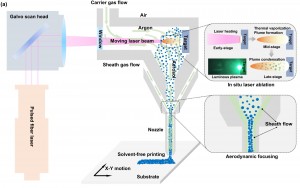
The Optica Foundation released detailed information on information technology research funded by the 2023 Optica Foundation Challenge. Researchers Zaijun Chen, University of Southern California, USA, and Alejandro Velez-Zea, Universidad de Antioquia, Colombia, both proposed novel approaches to addressing the flow of data and information in consumer-centric technologies.
“The growing use of ‘smart’ consumer technologies and augmented and virtual reality is simultaneously maxing out bandwidth and driving a desire for better experiences,” said Ulrike Woggon, member of the Challenge Selection Committee. “Drs. Chen and Velez-Zea are introducing unique, innovative ways to address these issues by lessening the network burden and creating more seamless interactions and realistic environments.”

2023 Optica Foundation Challenge researchers Alejandro Velez-Zea, Universidad de Antioquia, Colombia, and Zaijun Chen, University of Southern California, USA both proposed novel approaches to addressing the flow of data and information in consumer-centric technologies. Credit: Optica.
Both of the research efforts are supported by a USD$100,000 grant from the Optica Foundation, and Chen and Velez-Zea will use these funds to advance their work in the following ways:
Smart optical sensors for IoT
- Zaijun Chen, University of Southern California, USA
Accelerating optical edge sensing with photonic deep learning
Worldwide spending on the Internet of Things (IoT) is forecast to reach USD$806 billion this year, an increase of 10.6% over 2022, with a compound annual growth rate (CAGR) of 10.4% through 2027. These robust increases translate to network demand, and existing optical sensing networks demonstrate large energy consumption, data traffic, and long latency that create stopgaps for new requirements.
Now, work from Zaijun Chen, University of Southern California, USA, points to the promise of smart optical sensors that combine optical neural network processors with optical sensing for a more efficient solution. In today’s existing process, optical signals need to be converted to the electrical domain as part of the flow of information. Chen proposes a novel, smart optical sensor that can detect and process optical signals without the need for conversion, thus reducing energy consumption, latency, data traffic, and sensor footprint by orders of magnitude.
“This is a new field of study,” shared Chen. “We are trying to sense and combine optics and electronics with optical machine learning to process information more effectively and efficiently. It’s a unique approach to an existing problem.”
In three months, Chen expects to have a prototype of the first smart sensing device ready for testing, and from there, will begin training it on machine learning models that speak to specific IoT needs.
More realistic holography for AR/VR
- Alejandro Velez-Zea, Universidad de Antioquia, Colombia
Multilayer holographic augmented reality with digital micromirror devices: content pipeline and system implementation
The augmented reality/virtual reality (AR/VR) landscape has seen a rapid rise—standalone headsets have had a compound annual growth rate (CAGR) of 57.5% and by 2027, the market is expected to reach 30.3 million units globally. But as these products proliferate, their users become more sophisticated and strive for more realistic experiences, pushing technological advances.
Research from Alejandro Velez-Zea, Universidad de Antioquia, Colombia, seeks to deliver on that demand. Today, virtual reality headsets are primarily based on two flat images that give the impression of 3D, but the brain knows it’s not truly an immersive experience. By applying an array of mirrors that can rotate at very high speeds to change the direction of incoming light, Velez-Zea proposes a more comprehensive, authentic experience. Using digital micromirror devices (DMD), Velez-Zea and his team will create a modern AR/VR environment that is less costly than existing offerings.
“I’m very passionate about the next revolution in AR/VR technology and how we present information using light to show the real world,” shared Velez-Zea. “Our goal is to enable a new generation of much more affordable augmented reality solutions.”
Velez-Zea intends to develop a prototype system to demonstrate the capabilities of holographic augmented reality, but that work starts with testing algorithms to improve the limitations of DMDs. In six months, he and his team hope to finalize a prototype design and then focus on ways to optimize the experience and shrink the device’s size for easier portability.
These research initiatives were made possible through the Optica Foundation Challenge grants. This challenge was designed to engage early-career professionals in out-of-the-box thinking and provide seed money to investigate hypotheses in the areas of environment, health and information. Each recipient received USD$100,000 to explore their ideas and take steps toward addressing critical global issues. Recipients have begun working on these projects and expect to report initial results in 2024. For more information, visit optica.org/Challenge.
Optica Foundation
Established in 2002, the Optica Foundation carries out charitable activities in support of the society’s student and early career members. We cultivate the next generation of leaders and innovators as they navigate advanced degree programs and become active members of research, engineering and business communities worldwide. The foundation also works to secure the endowments for Optica’s awards and honors programs. The foundation is registered as a 501(c)(3) non-profit. For more information, visit optica.org/foundation.































 Back to News
Back to News































